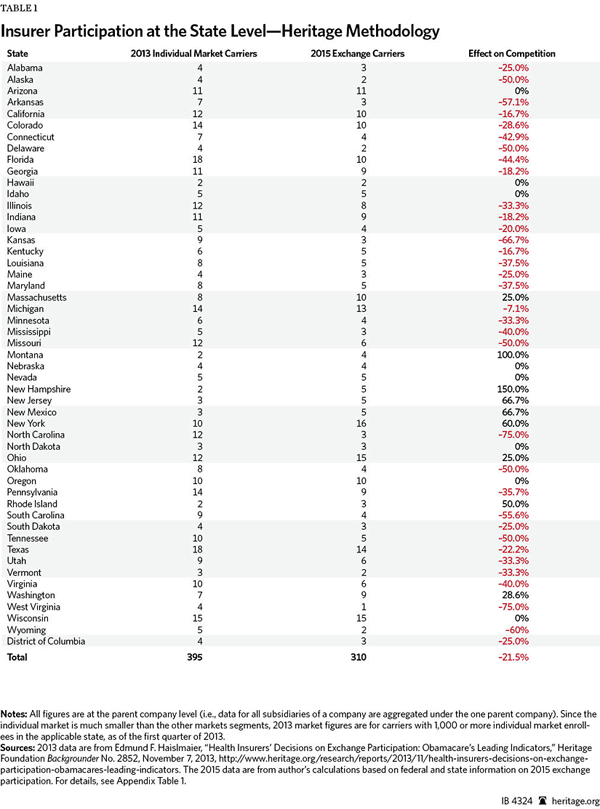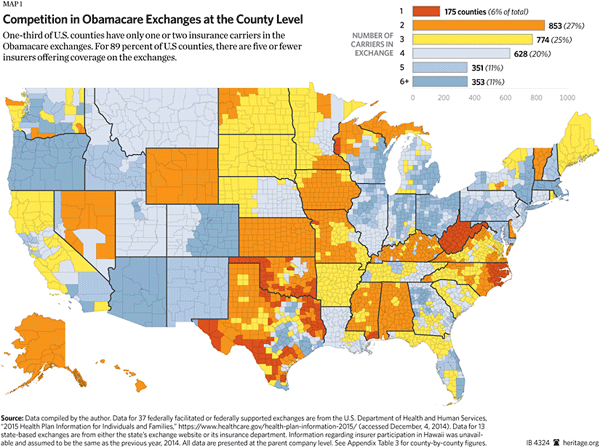My guiding principle is, and always has been, that consumers do better when there is choice and competition. That’s how the market works. Unfortunately, in 34 states, 75 percent of the insurance market is controlled by five or fewer companies. In Alabama, almost 90 percent is controlled by just one company. And without competition, the price of insurance goes up and quality goes down.
—President Barack Obama, September 9, 2009[1]
The government-run insurance exchanges created by the Affordable Care Act (ACA) are conducting their second annual open enrollment period. The Obama Administration has touted an increase in insurer participation in the exchanges for the 2015 plan year.[2]
However, while insurer participation in the exchanges is greater in 2015 than in 2014, it is still significantly less than the level of choice and competition that existed in the individual market prior to the ACA’s implementation. Many consumers purchasing health coverage in the exchanges face an extremely limited choice of insurers, and in some counties they have no choice at all.
Measuring Choice and Competition in the Exchanges
This Heritage Foundation analysis reviews state-level insurer participation in the exchanges for 2015 in federally facilitated and state-based exchanges in all 50 states and compares those results with insurer participation in states in the pre-ACA individual market.[3] The 2015 exchange participation is also compared with 2014 insurer exchange participation. This analysis also reviews the level of insurer participation on a county level for 2015 and compares those results with 2014 county-level participation.
2015 State-Level Choice and Competition
A comparison of insurer participation in the exchanges with the number of insurers that sold individual policies in the states before the law took effect shows that the exchanges remain considerably less competitive at the state level in 2015 than the 2013 individual market, the last year before the implementation of the ACA.
- The exchange market is 21.5 percent less competitive based on a comparison of the number of participating exchange insurers across all 50 states in 2015 with the number of carriers in the individual market in 2013. (See Table 1.)
- A 2014 Heritage Foundation analysis comparing the number of insurers participating in the exchanges in 2014 with the number of carriers selling coverage in each state’s individual market in 2013 (prior to ACA implementation) found that, nationally, the exchanges in 2014 were 36 percent less competitive than the 2013 individual market.[4] Thus, while the exchanges are more competitive in 2015 than in 2014, they are still less competitive than the pre-ACA market.
The Government Accountability Office (GAO) measured insurer competition in the pre-ACA individual market using a broader methodology than Heritage’s analysis.[5] According to the GAO, 1,232 carriers sold fully insured individual-market coverage nationwide in 2013, and this analysis finds that only 310 insurers are selling coverage on the exchanges nationwide in 2015. (See Appendix Table 2.)[6] Thus, the ACA’s exchanges are 75 less competitive than the pre-ACA individual market under the GAO’s methodology.
2015 County-Level Choice and Competition
While state-level data are instructive, from the consumer perspective a more relevant measure of choice and competition is at the county level because plans are offered (and priced) on a local basis and not all insurance carriers offer coverage statewide.
Consumers in one-third of the 3,134 counties in the United States face an exchange market that is either an insurer monopoly or duopoly in 2015. (See Map 1 and Appendix Table 3.) This means that residents in these counties have only one or two insurers from which to choose. When compared with 2014,[7] county-level competition has improved in some instances for 2015, but competition is still very limited for a significant share of the country.
- In 2015, 89 percent of total U.S. counties will have five or fewer companies selling coverage in the exchanges. In 2014, 94 percent of counties had five or fewer insurers on the exchange.
- In 2015, the exchange market in 57 percent of U.S. counties will feature competition among three or fewer insurers. In 2014, 78 percent of all counties had three or fewer insurers.
- In Texas, 62 percent of the state’s counties have only one or two insurers offering coverage in the exchange in 2015. There are 14 different insurers selling policies on the Texas exchange, but no Texas county has more than nine carriers offering coverage.
- West Virginia still has only one insurer offering coverage on the exchange in 2015. Thus, any state resident purchasing coverage on the ACA’s exchange has no choice of insurer.
Less Choice, Less Competition, and Higher Cost
Measuring insurer participation offers one measure of choice and competition. As both the state-level and county-level analyses show, insurer choice for many Americans will still be limited in the ACA’s exchanges in 2015.
The ACA’s mandated benefits and insurance rules also affect choice and competition. By design, these rules largely standardize insurance plans, consequently limiting consumers’ coverage choices, regardless of the number of participating insurers in the exchanges.
These benefit requirements and insurance rules also drive up the cost of coverage. In 2014, a Heritage study found that 42 of the 47 states for which comparable premium data were available saw significant increases in average premiums—in many cases, over 100 percent—for individuals purchasing from the exchanges compared with plans before the ACA.[8]
In 2015, a McKinsey & Company analysis of preliminary premium data in 18 states and the District of Columbia found:
[G]ross premiums (the amounts charged by carriers) could increase for 65 percent of renewal products; the median price increase for this subset is 9 percent ($299 annually for a 40-year-old nonsmoker). For 28 percent of renewal products, rates could increase more than 10 percent.[9]
In addition to higher premiums, many Americans purchasing coverage on the exchanges face higher deductibles. The Kaiser Family Foundation found that combined medical and drug deductibles for the average bronze plan is $5,331 in 2015, and the average silver deductible is $2,563.[10]
Real Choice and Real Competition Needed
By the standards of the President’s own “guiding principle,” his law largely fails. Although insurer participation in the exchanges has increased for 2015 compared with the previous year, it is still well below the level in the individual market prior to the law’s implementation. The flawed policies in the ACA neither foster competition nor increase consumer choice, and they will continue to harm American consumers and increase costs.
Congress should instead base reforms on increasing insurer competition and expanding coverage options for consumers.[11] A truly competitive marketplace would not be restrained by federal dictates and would have the flexibility to respond to consumer demands, resulting in lower health insurance costs and higher quality.
—Alyene Senger is a Research Associate in the Center for Health Policy Studies, of the Institute for Family, Community, and Opportunity, at The Heritage Foundation.




